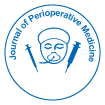
Journal of Perioperative Medicine
Open Access
ISSN: 2684-1290

ISSN: 2684-1290
Commentary - (2025)Volume 8, Issue 1
As global populations age, surgical services are increasingly confronted with the challenge of managing elderly patients with complex health profiles. Chronological age alone is no longer considered a reliable indicator of a patient’s ability to tolerate surgical interventions. Instead, frailty, a multidimensional syndrome characterized by decreased physiological reserve and resilience to stressors, has emerged as a more precise predictor of perioperative risk. In high income countries, where elderly populations are rapidly expanding, there is an urgent need to integrate frailty assessment into routine preoperative evaluation to improve surgical outcomes and tailor perioperative care.
Frailty affects an estimated 10% to 25% of individuals aged 65 and older, with prevalence rising significantly among those over 80. It is associated with poor outcomes across medical and surgical domains, including increased susceptibility to infection, delayed wound healing, prolonged hospital stays, functional decline and mortality. In the perioperative context, frail patients consistently experience higher rates of postoperative complications, ICU admissions, and readmissions, as well as lower quality of life and independence after surgery.
Multiple tools have been developed to assess frailty in the preoperative setting, including the Fried Frailty Phenotype, the Clinical Frailty Scale (CFS) and the Edmonton Frail Scale. These tools vary in complexity but share a common goal: Identifying patients with reduced functional reserves who may not recover well from the physiological stress of surgery. Among them, the CFS has gained popularity due to its simplicity, clinical relevance and ease of integration into preoperative workflows.
Research from high-income healthcare systems has consistently demonstrated the predictive value of frailty assessment. Studies from the UK, Canada and the United States show that preoperative frailty scores are independently associated with increased risk of adverse outcomes even after adjusting for age, comorbidities and surgical complexity. For instance, a prospective cohort study at a major UK tertiary hospital found that elderly frail patients undergoing abdominal surgery were five times more likely to develop major complications than their non-frail counterparts.
Beyond risk prediction, identifying frailty before surgery enables clinicians to engage in meaningful shared decision making with patients and families. Acknowledging the increased risk empowers patients to make informed choices, including consideration of less invasive treatment options or palliative approaches when appropriate. It also supports goal concordant care, aligning perioperative planning with the patient's values, life expectancy and functional priorities.
Importantly, recognizing frailty preoperatively also opens the door to rehabilitation interventions that aim to optimize a patient’s physical and psychological condition before surgery. Rehabilitation programs may include customized exercise regimens, nutritional support, medication optimization and psychosocial interventions. Evidence suggests that even short-term rehabilitation can improve surgical tolerance and enhance postoperative recovery in frail individuals.
Despite its demonstrated value, frailty assessment remains inconsistently applied in clinical practice. Barriers include time constraints, lack of standardization, limited clinician training, and insufficient integration into electronic health systems. In high-income countries with well-developed healthcare infrastructure, these challenges are not insurmountable. Several centres have begun embedding frailty screening into electronic preoperative pathways and multidisciplinary assessment clinics, led by geriatricians or perioperative medicine specialists.
The integration of frailty into surgical risk stratification also has significant implications for resource allocation. Hospitals can better anticipate postoperative needs such as critical care, physiotherapy, or rehabilitation services when frailty is considered during surgical planning. Furthermore, in an era of rising healthcare costs, identifying patients at higher risk of complications allows for more efficient use of resources and potentially reduces avoidable readmissions and prolonged hospital stays.
Preoperative frailty is a critical yet underutilized predictor of postoperative outcomes in elderly surgical patients. As highincome countries face mounting pressure to deliver safe and effective care to aging populations, incorporating frailty assessment into routine preoperative evaluation is no longer optional it is essential. Frailty screening enhances risk prediction, supports shared decision-making and opens opportunities for targeted interventions such as rehabilitation.
To fully realize the benefits of frailty-informed perioperative care, healthcare systems must commit to standardized assessment, workforce training and multidisciplinary collaboration. When implemented thoughtfully, frailty assessment not only improves surgical outcomes but also promotes person-cantered care that respects the dignity, autonomy and values of older adults. In the evolving landscape of geriatric surgery, acknowledging frailty is not a limitation it is a step toward precision, compassion and safer surgery for all.
Citation: Thornton EG (2025). Preoperative Frailty as a Predictor of Postoperative Outcomes in Elderly Patients. J Perioper Med. 8:262.
Received: 05-Feb-2025, Manuscript No. JPME-25-37972; Editor assigned: 07-Feb-2025, Pre QC No. JPME-25-37972 (PQ); Reviewed: 22-Feb-2025, QC No. JPME-25-37972; Revised: 02-Mar-2025, Manuscript No. JPME-25-37972 (R); Published: 09-Mar-2025 , DOI: 10.35248/2684-1290.23.8.262
Copyright: © 2025 Thornton EG. This is an open-access article distributed under the terms of the Creative Commons Attribution License, which permits unrestricted use, distribution, and reproduction in any medium, provided the original author and source are credited.